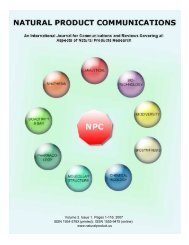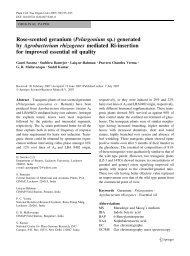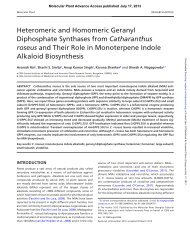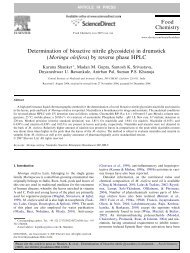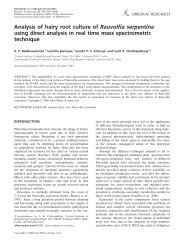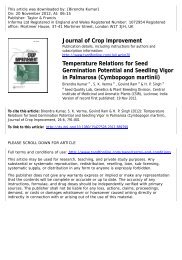Agrobacterium rhizogenes-mediated transformation of ... - CIMAP Staff
Agrobacterium rhizogenes-mediated transformation of ... - CIMAP Staff
Agrobacterium rhizogenes-mediated transformation of ... - CIMAP Staff
- No tags were found...
You also want an ePaper? Increase the reach of your titles
YUMPU automatically turns print PDFs into web optimized ePapers that Google loves.
Plant Biotechnol Rep (2007) 1:169–174<br />
DOI 10.1007/s11816-007-0029-0<br />
ORIGINAL ARTICLE<br />
<strong>Agrobacterium</strong> <strong>rhizogenes</strong>-<strong>mediated</strong> <strong>transformation</strong><br />
<strong>of</strong> Picrorhiza kurroa Royle ex Benth.: establishment<br />
and selection <strong>of</strong> superior hairy root clone<br />
Praveen Chandra Verma Æ Laiq ur Rahman Æ<br />
Arvind Singh Negi Æ Dharm Chand Jain Æ<br />
S. P. S. Khanuja Æ Suchitra Banerjee<br />
Received: 16 April 2007 / Accepted: 15 May 2007 / Published online: 3 August 2007<br />
Ó Korean Society for Plant Biotechnology and Springer 2007<br />
Abstract A protocol for induction and establishment <strong>of</strong><br />
<strong>Agrobacterium</strong> <strong>rhizogenes</strong>-<strong>mediated</strong> hairy root cultures <strong>of</strong><br />
Picrorhiza kurroa was developed through optimization <strong>of</strong><br />
the explant type and the most suitable bacterial strain. The<br />
infection <strong>of</strong> leaf explants with the LBA9402 strain resulted<br />
in the emergence <strong>of</strong> hairy roots at 66.7% relative<br />
<strong>transformation</strong> frequency. Nine independent, opine and<br />
TL-positive hairy root clones were studied for their<br />
growth and specific glycoside (i.e., kutkoside and picroside<br />
I) productivities at different growth phases. Biosynthetic<br />
potentials for the commercially desirable active<br />
constituents have been expressed by all the tested hairy<br />
root clones, although distinct inter-clonal variations could<br />
be noted in terms <strong>of</strong> their quantity. The yield potentials <strong>of</strong><br />
the 14-P clone, both in terms <strong>of</strong> biomass as well as<br />
individual glycoside contents (i.e., kutkoside and picroside<br />
I), superseded that <strong>of</strong> all other hairy root clones along<br />
with the non-transformed, in vitro-grown control roots <strong>of</strong><br />
P. kurroa. The present communication reports the first<br />
successful establishment, maintenance, growth and selection<br />
<strong>of</strong> superior hairy root clone <strong>of</strong> Picrorhiza kurroa with<br />
desired phyto-molecule production potential, which can<br />
serve as an effective substitute to its roots and thereby<br />
prevent the indiscriminate up-rooting and exploitation <strong>of</strong><br />
this commercially important, endangered medicinal plant<br />
species.<br />
Keywords <strong>Agrobacterium</strong> <strong>rhizogenes</strong> Hairy roots <br />
Glycosides Picrorhiza kurroa Growth index<br />
Abbreviations<br />
BAP benzyl amino purine<br />
IBA indole-3-butyric acid<br />
NAA a-naphthalene acetic acid<br />
TL Left-terminus DNA<br />
Introduction<br />
<strong>CIMAP</strong> Publication No.: 2007-28J<br />
P. C. Verma<br />
National Botanical Research Institute,<br />
Lucknow, UP 226001, India<br />
L. ur Rahman A. S. Negi D. C. Jain <br />
S. P. S. Khanuja<br />
Central Institute <strong>of</strong> Medicinal and Aromatic Plants,<br />
P.O. <strong>CIMAP</strong>, Lucknow, UP 26015, India<br />
S. Banerjee (&)<br />
Plant Tissue Culture Division,<br />
Central Institute <strong>of</strong> Medicinal and Aromatic Plants,<br />
P.O. <strong>CIMAP</strong>, Lucknow, UP 26015, India<br />
e-mail: sbanerjee_cimapin@indiatimes.com<br />
Plant-based molecules are continuously gaining widespread<br />
acceptance due to their effective therapeutic<br />
properties (Dubey et al. 2004). A wide range <strong>of</strong> such<br />
plant-derived molecules <strong>of</strong> pharmaceutical interest accumulates<br />
in plant roots as secondary metabolites, which<br />
necessitates uprooting and killing <strong>of</strong> the whole plant for<br />
harnessing the compound. Indiscriminate exploitation <strong>of</strong><br />
the natural resources through unregulated uprooting coupled<br />
with the lack <strong>of</strong> attention towards strategic cultivation<br />
practices have led to the endangered or threatened<br />
conditions <strong>of</strong> several high-altitude important medicinal<br />
plant species (Kumar et al. 1997). Realizing the threat <strong>of</strong><br />
extinction <strong>of</strong> such endangered medicinal plant species,<br />
123
170 Plant Biotechnol Rep (2007) 1:169–174<br />
attention has already been focused towards developing<br />
production alternatives <strong>of</strong> root-derived phytomolecules in<br />
order to meet the growing demand <strong>of</strong> pharmaceutical<br />
industries. The role <strong>of</strong> <strong>Agrobacterium</strong> <strong>rhizogenes</strong>-<strong>mediated</strong><br />
‘‘hairy root’’ cultures as an efficient production<br />
alternative has undeniably proved its effectiveness in the<br />
worldwide arena (Guillon et al. 2006a, b; Hu and Du<br />
2006). The stride <strong>of</strong> hairy root technology from the<br />
boundaries <strong>of</strong> research laboratories to industrial-scale<br />
production strategies has magnificently been manifested<br />
through the advent <strong>of</strong> the German company ROOTec<br />
(http://www.rootec.com), devoted fully towards up-scaling<br />
the hairy root technology as a production alternative at the<br />
industrial level for two important phytomolecules <strong>of</strong><br />
endangered plant origin.<br />
In the backdrop <strong>of</strong> these developments and in continuance<br />
to our earlier research effort (Verma et al. 2002), it<br />
was felt essential to focus our analogous research attention<br />
towards another very important and critically endangered<br />
medicinal plant species, i.e., Picrorhiza kurroa, which<br />
yields clinically proven hepato-protective and immunomodulating<br />
glycosides in its underground parts (Anonymous<br />
2001; Gupta et al. 2006).<br />
Picrorhiza kurroa Royle ex Benth belongs to the<br />
family Scrophulariaceae and is an endemic plant <strong>of</strong> the<br />
alpine Himalayan range <strong>of</strong> India. The roots and rhizomes<br />
<strong>of</strong> 3–4-year-old P.kurroa plants yield a crystalline<br />
product called ‘‘kutkin,’’ which is usually a mixture <strong>of</strong><br />
two major C9-iridoid glycosides, i.e., picroside-I (6-O<br />
-trans cinnamoylcatalpol) and kutkoside (10-O-vaniloylcatalpol)<br />
(Kumar et al. 2004). Significant hepatoprotective,<br />
anticholestatic, antiulcerogenic, antiasthematic,<br />
antidiabetic, anti-inflammatory and immuno-regulatory<br />
functions have already been ascribed to these glycosides<br />
for which the extracts <strong>of</strong> the underground parts <strong>of</strong> this<br />
plant finds applications as the major component in several<br />
Indian herbal preparations (Ram 2001; Thyagarajan<br />
et al. 2002).<br />
In order to address the problem <strong>of</strong> unregulated trade <strong>of</strong><br />
the underground parts <strong>of</strong> P. kurroa and to impede the<br />
adulteration <strong>of</strong> the raw materials to be used for herbal<br />
preparations, it seems highly desirable to explore the immense<br />
potential <strong>of</strong> the hairy root system <strong>of</strong> this presently<br />
unexplored medicinal plant species. This communication<br />
highlights the significant progress made in the afore-mentioned<br />
directions that have helped to address the concern<br />
involving this particular endangered medicinal plant species<br />
P. kurroa through the establishment and selection <strong>of</strong><br />
fast-growing, high-yield hairy root clone(s). The current<br />
research findings will help in bringing the prospect <strong>of</strong><br />
achievable, root-derived phytomolecules from hairy root<br />
cultures <strong>of</strong> P. kurroa another step closer to industrial<br />
exploitation.<br />
Materials and methods<br />
Induction and establishment <strong>of</strong> hairy roots<br />
Picrorhiza kurroa plants (8–10 weeks), maintained under<br />
in-vitro conditions on semisolid MS (Murashige and Skoog<br />
1962) medium supplemented with 2.0 mg L –1 BAP and<br />
0.1 mg L –1 NAA, were used as the explant source. The<br />
young leaves and stem segments were inoculated through<br />
pricking with a 48-h-old suspension culture <strong>of</strong> A. <strong>rhizogenes</strong><br />
strains, namely LBA 9402 and A 4 (kind gift from<br />
Pr<strong>of</strong>. D. Tepfer, INRA, Versailles Cedex, France), grown<br />
in liquid YMB (Hooykass et al. 1977) medium (O.D 600 =<br />
0.9–1.0). After 48 h <strong>of</strong> co-cultivation with the individual<br />
bacterial strain, the explants were transferred onto the same<br />
respective medium containing 1.0 g L –1 <strong>of</strong> cephalaxin<br />
(Ranbaxy, India) under dark conditions. Similar types <strong>of</strong><br />
explants, pricked with a sterile needle devoid <strong>of</strong> the bacterial<br />
suspension, were cultured under uniform conditions<br />
as controls. The emerging hairy roots were subsequently<br />
transferred to the half and full strengths <strong>of</strong> the B 5 medium<br />
(Gamborg et al. 1968) containing 3% (w/v) sucrose for<br />
their further proliferation. Once established, the individual<br />
hairy root clones were transferred to liquid B 5 medium<br />
with the same concentration <strong>of</strong> antibiotic and incubated on<br />
a rotary shaker in the dark at 25 ± 1°C under constant<br />
agitation (80 rpm). The antibiotic concentration was progressively<br />
lowered and finally completely omitted after<br />
4 months. The crushed hairy root extracts were streaked on<br />
semisolid YMB medium to check for the presence <strong>of</strong><br />
A. <strong>rhizogenes</strong> at this stage. Roots excised from in vitrogrown<br />
complete plantlets <strong>of</strong> P. kurroa were cultured under<br />
identical conditions in liquid B 5 medium supplemented<br />
with 1.0 mg L –1 IBA to serve as control roots.<br />
Growth kinetic studies<br />
The growth characteristics <strong>of</strong> 25 independently generated<br />
hairy root clones were evaluated on the basis <strong>of</strong> total root<br />
elongation (cm), lateral branching per centimeter <strong>of</strong> primary<br />
roots and fresh weight (FW) increment after 15 days<br />
<strong>of</strong> incubation in full- and half-strength liquid B 5 medium<br />
containing 3% sucrose. On the basis <strong>of</strong> the apparent growth<br />
behaviors with respect to these specific parameters, nine<br />
individual root clones were selected for further studies.<br />
All nine hairy root clones and the control, non-transformed<br />
roots were subjected to growth kinetic analysis for<br />
growth kinetic studies, 100 mg <strong>of</strong> actively growing hairy<br />
roots from 15 days old cultures were transferred to 250-ml<br />
Erlenmeyer flasks containing 50 ml <strong>of</strong> half-strength B 5<br />
medium with 3% sucrose, and their growth performances<br />
were determined following the method described earlier<br />
(Verma et al. 2002). The selected superior hairy root clone<br />
123
Plant Biotechnol Rep (2007) 1:169–174 171<br />
was cultured in 1 l half-strength B 5 medium for scale up<br />
studies.<br />
Characterization <strong>of</strong> hairy roots<br />
To prove the transformed nature <strong>of</strong> these nine hairy root<br />
clones, opines were extracted and detected by paper electrophoresis<br />
according to the procedure <strong>of</strong> Morgan et al.<br />
(1987) in parallel to extracts from non-transformed in vitro-grown<br />
control roots. Their transformed nature was<br />
further ascertained through PCR analysis according to the<br />
procedure described by Rahman et al. (2004) using TLspecific<br />
primer.<br />
Chemical analysis<br />
The time course production <strong>of</strong> the desired secondary<br />
metabolites, i.e., kutkoside and picroside I, was determined<br />
by subjecting these dried root samples to a chemical<br />
extraction process. The extraction <strong>of</strong> glycosides and HPLC<br />
analysis for kutkoside and picroside I was carried out<br />
according to the procedure reported by Gupta (2001) with<br />
minor modifications. The HPLC analysis was performed on<br />
reverse phase HPLC (Agilent HP 1100) with C 18 column<br />
(Waters Co., USA). The mobile phase (acetonitrile: water<br />
0–15 min at 15–20% and 16–35 min at 20–80%) was<br />
pumped at a flow rate <strong>of</strong> 1 ml min –1 . (Verma 2003). The<br />
cycle time <strong>of</strong> analysis was about 35 min. The compounds<br />
were identified on the basis <strong>of</strong> their retention time and<br />
comparison <strong>of</strong> UV spectra with the authentic standards.<br />
The quantification was repeated thrice for each sample, and<br />
the data were subjected to statistical analysis.<br />
strain compatibility has received substantial research<br />
attention over the years (Banerjee et al. 1995; Giri et al.<br />
2001; Hu and Du 2006). The clonal nature <strong>of</strong> individual<br />
hairy root lines has made it mandatory to screen and select<br />
the best performer among a wider, independently generated,<br />
heterogeneous background as reported in earlier<br />
analogous studies (Christey and Braun 2005).<br />
Characterization <strong>of</strong> hairy roots<br />
The transformed nature <strong>of</strong> the nine selected hairy root<br />
clones was confirmed through PCR analysis by the presence<br />
<strong>of</strong> rol B (670 bp) sequences from TL DNA <strong>of</strong> Ri<br />
plasmid (Fig. 1). The transformed nature was further confirmed<br />
by the presence <strong>of</strong> mannopine (Fig. 2).<br />
Growth behavior <strong>of</strong> hairy roots<br />
Nine potentially superior clones were selected on the basis<br />
<strong>of</strong> their growth performances among the 25 independently<br />
generated hairy root lines (data not presented). The<br />
Table 1 Frequency <strong>of</strong> hairy root induction from different explants<br />
following co-cultivation with two different strains <strong>of</strong> A. <strong>rhizogenes</strong><br />
Bacterial strain<br />
B5 medium<br />
Leaf<br />
Stem segment<br />
LBA 9402 66.7 ± 0.33 8.76 ± 1.56<br />
A4 NR NR<br />
NR no response<br />
Results and discussion<br />
Induction and establishment <strong>of</strong> hairy roots<br />
Visible roots were formed on the leaf explants after<br />
3 weeks <strong>of</strong> inoculation with the A. <strong>rhizogenes</strong> strain LBA<br />
9402 at 66.7% relative <strong>transformation</strong> frequency. On the<br />
other hand, the A 4 strain <strong>of</strong> A. <strong>rhizogenes</strong> appeared ineffective<br />
in inducing hairy roots in P. kurroa even after repeated<br />
trials. This is in agreement with earlier reports<br />
where bacterial strain specificity was found to play a<br />
determining role in establishing hairy roots (Byrne et al.<br />
1987; Porter 1991; Zehra et al. 1999; Torregrosa et al.<br />
2002).<br />
Among the two explants tested, leaf explants proved to<br />
be relatively better than the the stem explant (Table 1) both<br />
in terms <strong>of</strong> <strong>transformation</strong> frequencies and further growth<br />
potentials <strong>of</strong> the resulting hairy root clones. The imperative<br />
role <strong>of</strong> explants in determining the plant genotype-bacterial<br />
Fig. 1 PCR amplification <strong>of</strong> TL genes (670 bp) in hairy roots <strong>of</strong><br />
P.kurroa transformed with A. <strong>rhizogenes</strong> LBA 9402. Lane M 100 bp<br />
molecular marker (larger band is 500 bp); lane 1-8 randomly selected<br />
hairy root clones; nt non-transformed control in vitro grown roots <strong>of</strong><br />
P. kurroa<br />
Fig. 2 Opine assay <strong>of</strong> transformed hairy root tissues <strong>of</strong> P. kurroa;<br />
lane 1 standard mannopine; lane 2 untransformed control root; lane<br />
3–5 randomly selected transformed hairy root clones (n neutral<br />
sugars; m mannopine)<br />
123
172 Plant Biotechnol Rep (2007) 1:169–174<br />
productivity potentials <strong>of</strong> the selected clones, both in terms<br />
<strong>of</strong> biomass and secondary metabolites <strong>of</strong> interest at three<br />
different growth phases, are summarized in (Figs. 3, 4, 5).<br />
In terms <strong>of</strong> biomass productivity, a gradual increase in GI<br />
up to 40 days <strong>of</strong> culture could be noted with all these root<br />
clones, among which three clones (i.e., 7C, 3E and 4E)<br />
continued their growth till 60 days <strong>of</strong> culture, while the<br />
remaining six exhibited a decline in growth beyond<br />
the 40th day <strong>of</strong> culture. Statistical analysis revealed that the<br />
biomass production <strong>of</strong> four hairy root clones, i.e., lA, 2B,<br />
2D and 14P, differ significantly from that <strong>of</strong> the rest at their<br />
respective optimum growth phases (Fig. 3). The highest<br />
growth increment was exhibited by the 14P clone (Fig. 6),<br />
which was noted to be 29.6-fold after 40 days <strong>of</strong> culture.<br />
On the contrary, the control, non-transformed roots could<br />
attain a maximum <strong>of</strong> only 6.24 growth increments after<br />
60 days <strong>of</strong> culture in 1.0 mg L –1 IBA supplemented B 5<br />
medium, which was 4.1 times less than that <strong>of</strong> the 14P line.<br />
35<br />
30<br />
7C 4E 1A 2B 2D 3E 1D 2F P14 Nr<br />
Chemical pr<strong>of</strong>iling<br />
Biosynthetic potentials for the production <strong>of</strong> the root<br />
specific commercially desirable active constituents (i.e.,<br />
(% DW)<br />
content<br />
Picroside I<br />
0.7<br />
0.6<br />
0.5<br />
0.4<br />
0.3<br />
0.2<br />
0.1<br />
0<br />
7C 4E 1A 2B 2D 3E 1D 2F P14 Nr<br />
20 40 60<br />
Culture Period (No. <strong>of</strong> day)<br />
Fig. 5 Comparative analysis <strong>of</strong> picroside I productivities <strong>of</strong> nine<br />
independent hairy root clones and that <strong>of</strong> the non-transformed<br />
in vitro-grown control roots during three different growth phases.<br />
Values are the mean <strong>of</strong> triplicate results and error bars show standard<br />
deviations<br />
Growth index<br />
25<br />
20<br />
15<br />
10<br />
5<br />
0<br />
20 40 60<br />
Culture Period (No. <strong>of</strong> Day)<br />
Fig. 3 Comparative analysis <strong>of</strong> biomass yield (GI) production<br />
potential <strong>of</strong> nine independent hairy root clones and that <strong>of</strong> the nontransformed<br />
in vitro-grown control roots during three different growth<br />
phases. Values are the mean <strong>of</strong> triplicate results, and error bars show<br />
standard deviations<br />
(% DW)<br />
Kutkoside Content<br />
1<br />
0.9<br />
0.8<br />
0.7<br />
0.6<br />
0.5<br />
0.4<br />
0.3<br />
0.2<br />
0.1<br />
0<br />
7C 4E 1A 2B 2D 3E 1D 2F P14 Nr<br />
20 40 60<br />
Culture Period (No. <strong>of</strong> day)<br />
Fig. 4 Comparative analysis <strong>of</strong> Kutkoside productivities <strong>of</strong> nine<br />
independent hairy root clones and that <strong>of</strong> the non-transformed in vitro<br />
grown control roots during three different growth phases. Values are<br />
the mean <strong>of</strong> triplicate results, and error bars show standard deviations<br />
Fig. 6 The selected superior P14 hairy root clone <strong>of</strong> Picrorhiza<br />
kurroa cultured on hormone-free, half-strength B5 medium after<br />
10 days <strong>of</strong> culture (a) and after 40 days <strong>of</strong> culture (b)<br />
123
Plant Biotechnol Rep (2007) 1:169–174 173<br />
picroside-I and kutkoside) have been expressed by all the<br />
nine tested hairy root clones <strong>of</strong> P. kurroa, although distinct<br />
inter-clonal quantitative variations could be noted (Figs. 4,<br />
5). In seven <strong>of</strong> the nine hairy root lines studied (i.e., 1A,<br />
1D, 2B, 2D, 4E, 2F and P14), the product synthesis was<br />
found to be related to growth and maximum production <strong>of</strong><br />
the total glycoside, and as well that <strong>of</strong> the selected individual<br />
ones (i.e., picroside I and kutkoside) coincided with<br />
the exponential growth phase. Although the remaining two<br />
root clones (7C and 3E) complied with the growth-related<br />
total glycoside production pattern, their picroside I and<br />
kutkoside production potentials deviated from the abovementioned<br />
trend. Growth-related production behavior <strong>of</strong><br />
the active constituents has also been noted in a number <strong>of</strong><br />
other plant species by several investigators (Hamill et al.<br />
1986; Constabel and Towers 1988; Toivonen et al. 1991;<br />
Verma et al. 2002).<br />
It is interesting to note that the biosynthetic potential <strong>of</strong><br />
the 14P line, in terms <strong>of</strong> picroside-I and kutkoside content,<br />
superseded that <strong>of</strong> all other hairy root clones along with the<br />
non-transformed control roots <strong>of</strong> P. kurroa. Additionally,<br />
this selected 14P hairy root clone produced almost three<br />
times higher amounts <strong>of</strong> the total as well as individual<br />
glycosides compared to that <strong>of</strong> the control non-transformed<br />
roots at their respective optimum production phases.<br />
Moreover, the prescribed ratio between the two important<br />
components <strong>of</strong> Picrorhiza glycosides (i.e., picroside-I and<br />
kutkoside), as noted usually in the naturally grown roots<br />
(Kumar et al. 2004), has excellently been manifested by<br />
this selected 14P hairy root clone.<br />
The clonal nature <strong>of</strong> the individually selected hairy root<br />
lines resulting from site-specific insertion <strong>of</strong> Ri T-DNA and<br />
the difference in the incorporated copy numbers might<br />
have finally been responsible for such inter-clonal variation<br />
in the biosynthetic potentials in terms <strong>of</strong> the targeted<br />
compounds, as has already been reported in several other<br />
medicinal plant species (Wysokinska and Chmiel 1987;<br />
Mano et al. 1986, 1989; Yoshimatsu et al. 1990; Inomata<br />
et al. 1993; Zehra et al. 1999) (Fig. 6).<br />
Scale-up studies<br />
The biomass yield <strong>of</strong> the hairy root line 14P, when cultured<br />
in 1-l medium, was found to be 10.43 g (DW) in 40 days <strong>of</strong><br />
culture. In contrast, the 3-year-old field-grown P. kurroa<br />
plant is reported to yield 0.75 g dry roots/plant (Nautiyal<br />
et al. 2001), which is nearly 14 times less than that <strong>of</strong> the<br />
selected 14P hairy root line. Consequently, the kutkoside<br />
and picroside yield was noted to be nearly four-fold higher<br />
in the 14P line than the reported 3-year-old field-grown<br />
plant.<br />
Conclusion<br />
The outcome <strong>of</strong> the present investigation elucidates successful<br />
induction, growth, maintenance and selection <strong>of</strong> the<br />
rapidly growing hairy root line (14P) <strong>of</strong> P.kurroa with<br />
in vitro desired phytomolecule production potential. The<br />
superiority <strong>of</strong> the selected 14P hairy root clone in terms <strong>of</strong><br />
root biomass and kutkoside/picroside yield over the reported<br />
3-year-old field-grown P. kurroa plant (Nautiyal et al. 2001)<br />
undoubtedly highlights the significance <strong>of</strong> the present research<br />
endeavor, which can endow us with a substitute for<br />
the exploitation <strong>of</strong> this commercially important, endangered,<br />
hitherto unexplored medicinal plant species.<br />
Acknowledgments The authors wish to express their sincere thanks<br />
to Dr. Sushil Kumar (Ex-Director, <strong>CIMAP</strong>, Lucknow) for providing<br />
the necessary research facilities and constant encouragement. Heartfelt<br />
thanks are also due to Dr. R Pal (Senior Scientist, CDRI, Lucknow)<br />
for his constructive suggestions and requisite guidance.<br />
References<br />
Anonymous (2001) Picrorhiza kurroa Monograph. Altern Med Rev<br />
6:319–321<br />
Banerjee S, Zehra M, Kukreja AK, Kumar S (1995) Hairy roots in<br />
medicinal plants. Curr Res Med Arom Plants 17:348–378<br />
Byrne M, Mc Donnell R, Wright M, Carnes M (1987) Strain and<br />
genotype specificity in <strong>Agrobacterium</strong> soybean interaction. Plant<br />
Cell Tissue Organ Cult 8:3–5<br />
Christey MC, Braun RH (2005) Production <strong>of</strong> hairy root cultures and<br />
transgenic plants by <strong>Agrobacterium</strong> <strong>rhizogenes</strong>-<strong>mediated</strong> <strong>transformation</strong>.<br />
Methods Mol Biol 286:47–60<br />
Constabel CP, Towers GHN (1988) Thiarubine accumulation in hairy<br />
root cultures <strong>of</strong> Chaenactis douglasii. J Plant Physiol 133:67–72<br />
Dubey NK, Kumar R, Tripathi P (2004) Global promotion <strong>of</strong> herbal<br />
medicine: India’s opportunity. Curr Sci 86:37–41<br />
Gamborg OL, Miller RA, Ojima K (1968) Nutrient requirements <strong>of</strong><br />
suspension cultures <strong>of</strong> soybean root cells. Exp Cell Res 50:151–<br />
158<br />
Giri A, Ravindra ST, Dhingra V, Narasu ML (2001) Influence <strong>of</strong><br />
different strains <strong>of</strong> <strong>Agrobacterium</strong> <strong>rhizogenes</strong> on induction <strong>of</strong><br />
hairy roots and artemisinin production in Artemisia annua. Curr<br />
Sci 81:378–382<br />
Guillon S, Tremouillaux-Guiller J, Pati PK, Rideau M, Gantet P<br />
(2006a) Harnessing the potential <strong>of</strong> hairy roots: dawn <strong>of</strong> a new<br />
era. Trends Biotechnol 24:403–409<br />
Guillon S, Tremouillaux-Guiller J, Pati PK, Rideau M, Gantet P<br />
(2006b) Hairy root research: recent scenario and exciting<br />
prospects. Curr Opin Plant Biol 9:341–346<br />
Gupta PP (2001) Picroliv. Drugs Future 26:25–31<br />
Gupta A, Khajuria A, Singh J, Bedi KL, Satti NK, Dutt P, Suri KA,<br />
Suri OP, Qazi GN (2006) Immunomodulatory activity <strong>of</strong><br />
biopolymeric fraction RLJ-NE-205 from Picrorhiza kurroa. Int<br />
Immunopharmacol 6:1543–1549<br />
Hamil JD, Parr AJ, Robins RJ, Rhodes MJC (1986) Secondary<br />
product formation by cultures <strong>of</strong> Beta vulgaris and Nicotiana<br />
rustica transformed with <strong>Agrobacterium</strong> <strong>rhizogenes</strong>. Plant Cell<br />
Rep 5:111–114<br />
Hooykass PJJ, Klapwijk PM, Nuti PM, Shilperoot RA, Rorsch A<br />
(1977) Transfer <strong>of</strong> the <strong>Agrobacterium</strong> tumefaciens Ti-plasmid to<br />
123
174 Plant Biotechnol Rep (2007) 1:169–174<br />
a virulent Agrobacteria and Rhizobium explanta. J Gen Microbiol<br />
98:477–487<br />
Hu Zhi-Bi, Du Min (2006) Hairy roots and its application in plant<br />
genetic engineering. J Integr Plant Biol 48:121–127<br />
Inomata S, Yokoyama M, Gozu Y, Shimizu T, Yanagi M (1993)<br />
Growth pattern and ginsenoside production <strong>of</strong> <strong>Agrobacterium</strong>transformed<br />
Panax ginseng roots. Plant Cell Rep 12:681–686<br />
Kumar V, Mehrotra N, Lal J, Gupta RC (2004) Pattern pr<strong>of</strong>iling <strong>of</strong> the<br />
herbal preparation picroliv using liquid chromatography-tandem<br />
mass spectrometry. J Chromatogr A 1045:145–152<br />
Kumar S, Singh J, Shah NC, Ranjan V (1997) Picrorhiza kurroa. In:<br />
Sharma A, Kumar A, Tewari R, Hasan S. A (eds) Indian<br />
medicinal and aromatic plants facing genetic erosion. Published<br />
by Director, <strong>CIMAP</strong>, Lucknow, pp 169–172<br />
Mano Y, Nabeshima S, Matsui C, Ohkawa H (1986) Production <strong>of</strong><br />
tropane alkaloids by hairy root cultures <strong>of</strong> Scopolia japonica.<br />
Agric Biol Chem 50:2715–2722<br />
Mano Y, Ohkawa H, Yamada Y (1989) Production <strong>of</strong> tropane<br />
alkaloids by hairy root cultures <strong>of</strong> Duboisia leichhardtii transformed<br />
with <strong>Agrobacterium</strong> <strong>rhizogenes</strong>. Plant Sci 59:191–201<br />
Morgan AJ, Cox PN, Turner DA, Peel E, Davey MR, Gartland KMA,<br />
Mullingan BJ (1987) Transformation <strong>of</strong> tomato using an Ri<br />
plasmid vector. Plant Sci 49:37–49<br />
Murashige T, Skoog F (1962) A revised medium for rapid growth and<br />
bioassays with tobacco tissue cultures. Physiol Plant 15:473–497<br />
Nautiyal DP, Prakash V, Chauhan RS, Purohit H, Nautiyal MC (2001)<br />
Assessment <strong>of</strong> germinability, productivity, and cost benefit<br />
analysis <strong>of</strong> Picrorhiza kurrooa cultivated at lower altitudes. Curr<br />
Sci 81:579–585<br />
Porter JR (1991) Host range and implications <strong>of</strong> plant infection by<br />
<strong>Agrobacterium</strong> <strong>rhizogenes</strong>. Crit Rev Plant Sci 10:387–421<br />
Rahman LU, Ikenaga T, Kitamura Y (2004) Penicillin derivatives<br />
induce chemical structure-dependent root development, and<br />
application for plant <strong>transformation</strong>. Plant Cell Rep 22:668–677<br />
Ram VJ (2001) Herbal preparations as a source <strong>of</strong> hepatoprotective<br />
agents. Drug News Perspect 14:353–363<br />
Thyagarajan S, Jayaram S, Gopalakrishnan V, Hari R, Jeyakumar P,<br />
Sripathi M (2002) Herbal medicines for liver diseases in India. J<br />
Gastroenterol Hepatol 17 Suppl (3):S370–S376<br />
Toivonen L, Ojala M, Kauppinen V (1991) Studies on the optimization<br />
<strong>of</strong> the growth and indole alkaloid production by hairy root<br />
cultures <strong>of</strong> Catharanthus roseus. Biotechnol Bioeng 37:673–680<br />
Torregrosa L, Iocco P, Thomas MR (2002) Influence <strong>of</strong> <strong>Agrobacterium</strong><br />
strain, culture medium and cultivar on the <strong>transformation</strong><br />
efficiency <strong>of</strong> Vitis vinifera L. Am J Enol Vitic 53:183–190<br />
Verma PC, Singh D, Rahman LU, Gupta MM, Banerjee S (2002) In<br />
vitro studies in Plumbago zeylanica: rapid micro propagation<br />
and establishment <strong>of</strong> higher plumbagin yielding hairy root<br />
cultures. J Plant Physiol 159:547–552<br />
Verma PC (2003) Biotechnological approaches for in vitro production<br />
<strong>of</strong> picroliv from <strong>Agrobacterium</strong> <strong>rhizogenes</strong> <strong>mediated</strong> hairy root<br />
cultures <strong>of</strong> Picrorhiza kurroa Royle ex Benth. PhD Thesis,<br />
Lucknow University, Lucknow<br />
Wysokinska H, Chmiel A (1997) Transformed root cultures for<br />
biotechnology. Acta Biotechnol 17:131–159<br />
Yoshimatsu K, Satake M Shimomura K (1990) Determination <strong>of</strong><br />
cardinolides in hairy root cultures <strong>of</strong> Digitalis lantana by<br />
enzyme linked immunoassay. J Nat Prod 53:1498–1502<br />
Zehra M, Banerjee S, Sharma S, Kumar S (1999) Influence <strong>of</strong><br />
<strong>Agrobacterium</strong> <strong>rhizogenes</strong> strains on biomass and alkaloid<br />
productivity in hairy root lines <strong>of</strong> Hyoscyamus Muticus and H.<br />
albus. Planta Med 65:60–63<br />
123




